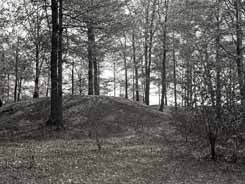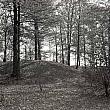
Indian Mounds
GRHC - December 8th, 2010
Grand Rapids original Indian Mounds have been replaced by reconstructions.
Transcript
Early missionaries and traders reported that the Indians of their day had no knowledge of the origin of these mounds. They only knew they were made by earlier men and had great veneration for them.
On the mission land along the west side of the Grand River, south of Bridge Street, stood forty-six mounds. When there was no longer use for the Mission land, it was sold by the government and eventually platted for residential and commercial purposes. During the 1850s that entailed a project of cutting down trees or filling up low places, and so the Indian mounds, with their historic contents, were carted away.
For several summers Charles Belknap, newspaper man and author of “The Yesterdays of Grand Rapids,” was a water boy for the Irish and Dutch immigrants who did the work. He wrote that he was able to collect flint arrowheads and other items that were unearthed in nearly every burial mound.
At that time, there was no regret over this leveling of the mounds. The men who gathered the curios reaped considerable financial benefit from their sales to museums. Some of these artifacts reside in our own museum.
Many fine homes were built on the Mission land, which eventually became a network of railroad tracks and busy factories as the city industrialized. Today, the mounds you see along the river are symbolic reconstructions representing those that were lost, and the Gerald R. Ford Presidential Museum, Ah-Nab-Awen Park, and the Public Museum have replaced the railroad tracks and factories.
Full Details
| Title | Indian Mounds |
|---|---|
| Creator | GRHC |
| Keywords | Glance at the Past, history, radio, Indian Mounds, Grand Rapids, Historical Commission, Podcast |
| Duration | 2:05 |
| Pubdate String | December 8th, 2010 |

 facebook
facebook